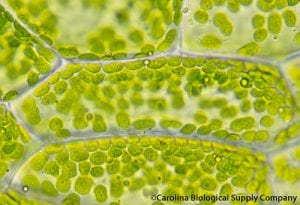
Recent research has revealed a connection between fundamental quantum mechanics and photosynthesis, a biochemical process converting the sun’s light energy into chemical energy. Source: Flickr
Recent research has revealed a connection between fundamental quantum mechanics and photosynthesis, a biochemical process converting the sun’s light energy into chemical energy (1).
The foci of this new quantum connection are antenna proteins and pigment molecules called chromophores that are crucial to the photosynthetic process (2). Prior to this research, the quantum nature of photosynthesis was theorized but not concretely described. Quantum effects, or the process of absorbing light packets and exciting molecules, were present in the antenna proteins of plant cells, but their role in processing solar photons was not explained – until recently (3).
Scientists used ultrafast spectroscopy, bombarding the relevant molecules with laser pulses lasting about a quadrillionth of a second, to show the “quantum connection” (1, 2). The laser pulses essentially mimicked the typical molecular absorption of sunlight. The antenna proteins absorbed the laser’s energy as they would the sun’s, and research has shown how the proteins process the energy. The primary discovery was that the photosynthetic conversion of solar energy to chemical fuel involves a quantum phenomenon known as “coherence” (4).
In technical terms, coherence is the state of quantum superposition, which means that absorbed solar energy resides in multiple places at once. “The analogy [is] if you have three ways of driving home through rush hour traffic. On any given day, you take only one. You don’t know if the other routes would be quicker or slower. But in quantum mechanics, you can take all three of these routes simultaneously. You don’t specify where you are until you arrive, so you always choose the quickest route,” said Greg Scholes, a biophysicist at the University of Toronto (1, 4).
With quantum coherence, electronic states are mixed and the energy loss associated with the conversion of solar energy to chemical energy is extremely small (1). The researchers performing the ultrafast spectroscopy found an obvious relationship grounded in trigonometry between the fluctuation of the laser across the antenna protein and the way the energy flowed through the protein. In other words, this fundamentally natural process is governed by quantum mechanical laws and can be described in mathematical terms (4, 5).
The photosynthetic process operates with the collusion of millions of molecules turning solar energy into fuel. In this regard, photosynthesis is much like a heat engine, which turns heat energy into mechanical energy. The newly discovered quantum nature of photosynthesis shows that nature’s process is effectively a very efficient heat engine. “[This] suggests that algae knew about quantum mechanics nearly two billion years before humans,” says Scholes (4).
The ramifications of the underlying quantum nature of photosynthesis are widespread. These findings could aid chemists, nanoscientists and materials scientists in creating imitations of the energy-efficient photosynthetic systems. Scholes predicts that the structure of the antenna proteins involved in photosynthesis will be used to improve solar cell technologies. Greg Engel, who led researchers two years ago at the University of California at Berkeley to find coherence in the antenna proteins of green sulfur bacteria, predicted the advent of a new scientific field called quantum biology (1).
The coherence of photosynthesis also leaves room for future research, such as whether or not these organisms developed a quantum method for solar energy conversion as an evolutionary advantage. Other researchers have suggested that quantum mechanics in biological processes aren’t limited to photosynthesis but can be extrapolated to how the brain functions, the way in which we smell, and how birds navigate the Earth’s geomagnetic fields (1).
References
1 Brandon Keim, Everywhere in a Flash: The Quantum Physics of Photosynthesis (28 February, 2013).
Available at
http://www.wired.com/wiredscience/2010/02/quantum-photosynthesis/
2 DOE/Argonne National Laboratory, Science Daily, Unusual Quantum Effect Discovered in Earliest Stages of Photosynthesis (28 February, 2013).
Available at
http://www.sciencedaily.com/releases/2012/05/120524092932.htm
3 Brandon Keim, More evidence found for quantum physics in photosynthesis (28 February, 2013).
Available at
http://arstechnica.com/science/2011/12/more-evidence-found-for-quantum-physics-in-photosynthesis/
4 Sean Bettam, Scientists find quantum mechanics at work in photosynthesis (28 February, 2013).
Available at
http://phys.org/news184423418.html#nRlv
5 Lisa Zyga, Study supports role of quantum effects in photosynthesis (28 February, 2013). Available at
http://phys.org/news/2012-01-role-quantum-effects-photosynthesis.html